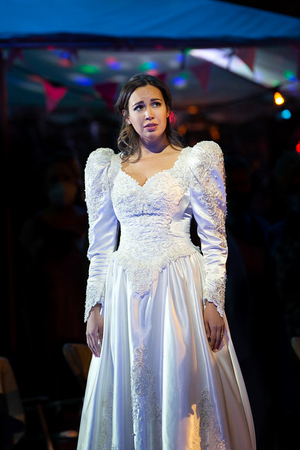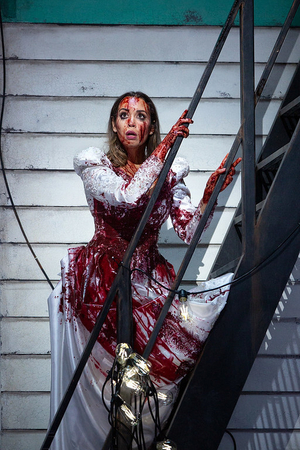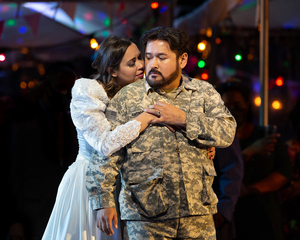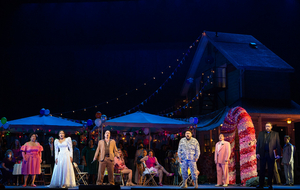Review: Soprano Nadine Sierra Makes a Splash – and a Splat – in Bloody New Simon Stone LUCIA at the Met
Tenor Camarena, Baritone Rucinski and Bass Rose Excel in Donizetti Drama under Conductor Frizza

Photo: Marty Sohl/The Met
Well, no one can say that the Met doesn't have guts.
After the tepid response that subscribers gave its Las Vegas version of Verdi's RIGOLETTO by Michael Mayer, no one would have suspected that they'd come up with a version of Donizetti's LUCIA DI LAMMERMOOR that made anything else it's produced look tame.
And while the new LUCIA isn't something that will send every Met attendee into quivers of excitement--I don't think I've ever heard so many pros and cons discussed at an intermission before--it won't send them to sleep either.
Of course, it's also something that composer Donizetti and his librettist Salvatore Cammarano (who based his story very loosely on Sir Walter Scott's "The Bride of Lammermoor") might have had a tough time recognizing. The opera on the Met's stage is a far cry in style from the one set in Scotland that they produced in 1835. The contemporary story takes place "in a declining present-day town in America's Rust Belt" but it's still LUCIA. It walks like a duck, quacks like a duck and looks like a duck, so it must be. And, let me tell you, it certainly isn't not dull, isn't irrelevant and doesn't make the heroine into a little wallflower who's sitting in the corner waiting to be saved.

Photo: Marty Sohl/The Met
Director Simon Stone--with cohorts Lizzie Clachan on set design, costume designers Alice Babidge and Blanca Anon, lighting pro James Farncombe, projection designer Luke Halls and choreographer Sara Erde--had an idea and ran with it, as if he planned to take the production to Trump country. I'm not so sure that I agreed with the way he used camera work to contrast some of the action on stage--some of it was definitely more distracting from the singers than necessary--but he certainly seemed committed to what he was doing.
The magnificent Nadine Sierra handled the long, difficult title role as if it were mother's milk, using every trick in the coloratura's playbook and making it seem like the most natural thing in the world. Maybe that's because, for her, it is natural and just plain remarkable.
Whether it was singing her first big set-piece, "Regnava nel silenzio," like she never heard the term "warm-up," or coming down the back stairs of a motel where she'd spent her wedding night giving Lizzie Borden a run for her money, in the opera's famous "Mad Scene," she's a stage animal with the best of them. (Her glass harmonica accompaniment by Friedrich Heinrich Kern added that special something to the particularly gory segment.) She even held her own when confronted by a chorus of bloody men who looked like extras who wandered in from "The Walking Dead."

Photo: Marty Sohl/The Met
Tenor Javier Camarena gave her a run for her money, as her true love Edgardo. While the role may be smaller than that of the title heroine, that doesn't mean it's easy. In what's usually the opera's "tomb scene," Camarena did a magnificent job on the pair of wonderfully grueling arias at the opera's end that are the heartfelt, mournful contrast to Lucia's madness. Unlike some other tenors who have to fight their way out of the BARBIER DI SIVIGLIA mode to bring greater drama into their voices, he seems to know what he's doing--and very well indeed.
Where was bass Matthew Rose when we needed him, as Phillipe II in DON CARLOS? He has the voice for that and then some (especially for "Elle ne m'aime pas" better known in its Italian version, "Ella giammai m'amò"). Here, his rolling tones were well used as Raimondo, the chaplain, giving us tantalizing bits like "Al ben de' tuoi qual vittima," where he's joined by Sierra.
As Lucia's brother, Enrico, who really set the opera in motion by using her as chattel for his failing finances, baritone Artur Rucinski was an effective brute. I'd admired him previously at the Met, but his warmup in Act I made me nervous about the state of his voice, though he made a quick recovery as the opera continued and provided a proper villain that we could "boo" at with glee.

Photo: Marty Sohl/The Met
The cast was rounded out nicely by tenor Eric Ferring as Arturo, the unfortunate bridegroom of Lucia, and mezzo Deborah Nansteel as her confident, Alisa, who played small, but key, roles in the opera's wonderful sextet, "Chi mi frena in tal momento," performed after Lucia's wedding along with Sierra, Camarena, Rucinski and Rose.
Does anyone have to mention the terrific work of the Met orchestra under Riccardo Frizza, who kept the troops on stage nicely in step, or the chorus under Donald Palumbo? As always, they were indispensable.
But is this production, i.e., this LUCIA, one for the ages? I wouldn't go that far--but it's an interesting take that might just bring some newcomers to the ranks of Met audiences. I'll drink to that.
For more information on future performances at the Met or in the Met in HD series, on May 21, please see the Met website.
Reader Reviews
Videos

